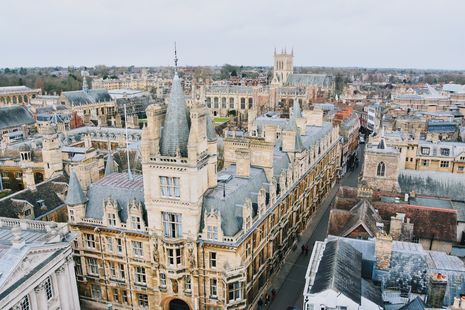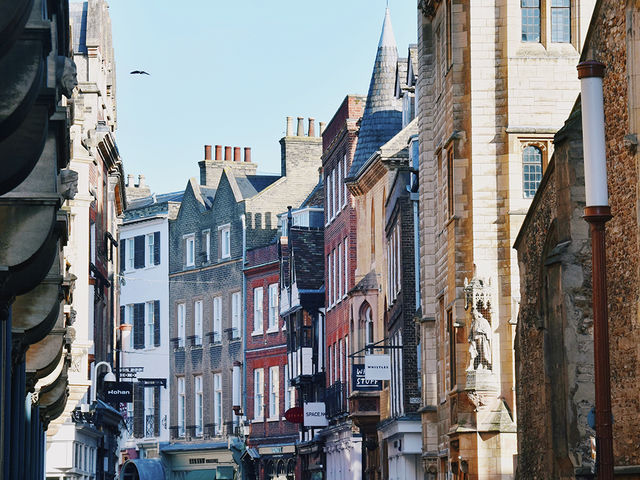Art in public: Interventions in Eddington
In his second piece on public art, Varsity’s Tom Ward shines a light on a student favourite – the ‘Rage Cage’

‘Wait – look, just now, on your left – can you see the Rage Cage?’ It was a crisp January morning, and my friend and I had just set off on a long drive to Wales. ‘The Rage Cage?’, I replied, utterly lost. ‘Yeah, the Rage Cage, where people went and partied when the clubs were closed.’ Although we didn’t see the Rage Cage from our vantage point in the car – even leafless, the trees obstructed the view – I did vaguely know what he was referring to. But I had no idea of the newfound function of this Eddington sculpture.
Known colloquially by many students as the Rage Cage, the Fata Morgana Teahouse (by Winter/Hörbelt, installed 2018) is a sculpture at Brook Leys, a small park area in Eddington that was designed as part of the local sustainable drainage system. Formed mostly of stainless steel, the structure looms above the lake, appearing from a distance to resemble a sort of abstract amalgam of tin cans. However, approaching the structure, its subtle textures become apparent; its seamless curves and internal fixtures become legible and the sculpture itself becomes almost translucent as the landscape beyond appears through its latticed frame.
“The world feels somehow quieter when sitting inside the teahouse”
Stepping inside, this conversation between the parkland and the sculpture is all the more fluid: in one direction moorhens and ducks can be seen bathing on the lake, in another, only reflections of light in the steel latticework, before this perspective shifts completely simply by taking a few steps forward. While this isn’t entirely unsurprising – the piece is literally named Fata Morgana – the effect is soothing, even calming, and the world feels somehow quieter when sitting inside the teahouse. Looking down on the lake from inside, ghostly behind the steel, it’s easy to see how the teahouse might be described as a bird hide. You only need to take a look at some of the litter (not condoned – use the bins!) on the floor of the sculpture, however, to recognise that this is a place of many functions.
“Surely a sculpture that elicits such a social response from those who interact with it can only be described as a success”
Ultimately, the presence of the teahouse as a place to socialise – the existence of the Rage Cage – illustrates the success of the sculpture. Students have interacted with the work, responded to its material, demanded of the work a symbolic function that was never peripheral to the piece, but always central: an evocation of the landscape, a reaction to the setting. Is this not the very essence of place-making? Surely a sculpture that elicits such a social response from those who interact with it can only be described as a success – it inspires questions of the function of public space, it demands a reaction from its audience (for want of a better term), it revels in the triumph of use over exchange. Only last week I spoke to an art consultant who told me about a cardboard sculpture that was commissioned as a temporary installation in a London park. ‘It was one of our most successful commissions’, they said, ‘because someone set it on fire. The artist was delighted!’ The Rage Cage, too, seems to me to be such an example: a sculpture that evokes such a response, that causes people to question, to imagine, to interact so directly with its form, is nothing short of an ingenious intervention in public space.
“Sometimes the best public artworks are those where people go to party when the clubs are closed”
Fata Morgana Teahouse is one of a number of commissions in Eddington, as part of the North West Cambridge Development’s wider Public Art Strategy. More than £3 million will have been spent on public art as part of the wider development scheme once complete. Another commission at Brook Leys, by the same artists, Winter/Hörbelt, can be seen when continuing past the teahouse. Pixel Wall is more subtle, a fifteen-metre curved screen of polished steel squares, reflecting the parkland in front. More than simply an ersatz mirror, it playfully responds to the light: whereas the teahouse is dulled and spectral in tone, the wall glistens in the sun, almost shimmering on the lakeside.
Less interactive, perhaps, is one of the more well-known public art commissions of late in Eddington. Richard Of York Gave Battle In Vain, by David Batchelor, is the set of seven illuminated LED rings by Sainsbury’s, seen frequently in marketing for either Eddington or the U Bus. Its name, the infamous mnemonic, is a reference to the fact that each of the seven rings is always a different colour of the rainbow: constantly on rotation, over the course of an hour each ring will transition through the spectrum. Decidedly louder than the Winter/Höbelt commissions, the work taps into an appreciation of colour that can often be lost in larger scale developments like that of North West Cambridge. Sure, this is the work that has become synonymous with Eddington – but, as the lure of the Rage Cage goes to show, colour and figuration aren’t everything. Sometimes the best public artworks are those where people go to party when the clubs are closed.
 News / Uni members slam ‘totalitarian’ recommendation to stop vet course 15 January 2026
News / Uni members slam ‘totalitarian’ recommendation to stop vet course 15 January 2026 Science / Why smart students keep failing to quit smoking15 January 2026
Science / Why smart students keep failing to quit smoking15 January 2026 Comment / Will the town and gown divide ever truly be resolved?12 January 2026
Comment / Will the town and gown divide ever truly be resolved?12 January 2026 Interviews / The Cambridge Cupid: what’s the secret to a great date?14 January 2026
Interviews / The Cambridge Cupid: what’s the secret to a great date?14 January 2026 Features / How sweet is the en-suite deal?13 January 2026
Features / How sweet is the en-suite deal?13 January 2026










